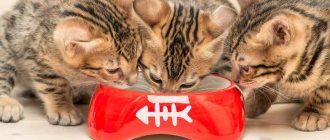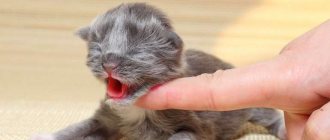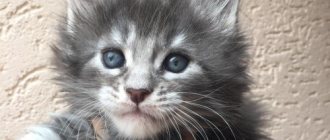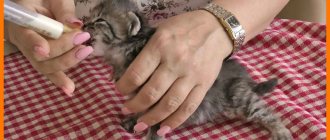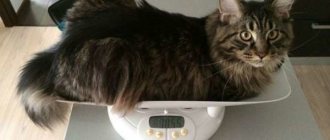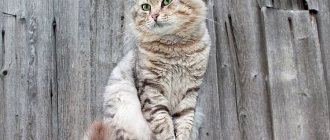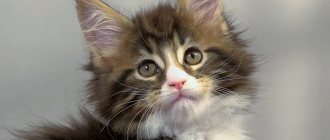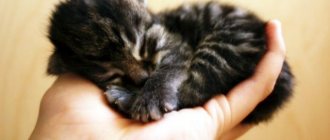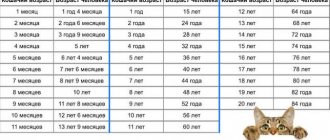Fifth week of life
Newborn kittens sleep and eat all the time.
Kittens are born blind, deaf, but with an already developed sense of smell - the baby is able to smell his mother at a distance of up to half a meter. Weight at birth is no more than 100 grams, length up to 10 cm. The wool is thin, thermoregulation is poorly developed, so they vitally need the presence of their mother, who will warm them. The skeleton is fragile and kittens require careful handling; it is better not to squeeze them or pick them up at all. Newborn babies sleep and eat almost all the time - adequate sleep will help the proper formation of the nervous system. They don’t know how to walk independently when they need to; the mother cat helps them by licking their genitals.
By the age of three days, the umbilical cord falls off, and on the fifth day the kitten begins to hear sounds. The baby cannot stand on its legs, but is quite capable of crawling short distances in search of its mother's nipple.
The kitten's weight doubles, the baby hears much better, but still has difficulty identifying the source of the sound.
By the end of the second week, the eyes appear: they are cloudy, blue and covered with a film, so the baby sees as if in a fog: only the outlines of objects.
The fur grows, becomes thicker, an undercoat appears, and the kitten can regulate the heat transfer itself, but it is still worth worrying about a warm nest for him and the mother cat.
The baby is still crawling - he will make attempts to stand up and take his first steps closer to the age of one month. Periods of wakefulness increase.
The kitten is getting heavier, he can already see, but his vision is not yet so sharp, so he often bumps into objects. The legs are still unstable, attempts to stand up end in failure. The baby is highly dependent on the care of the mother, but is quite capable of surviving with the help of a person if the mother goes somewhere. The first teeth are coming through.
At this age, babies are often separated from their mother, although it would be worth waiting another couple of weeks for the baby to learn good manners. The kitten is gradually transferred to special food or natural solid food. Breastfeeding is reduced to a minimum, and the mother cat no longer rushes to her babies at the first call of hunger, but prefers to feed them only at night.
Babies still sleep a lot, but physical activity is increasing: small pets play with pleasure and run around the rooms, which forces household members to be careful. You should always watch your step so as not to accidentally crush the tomboy.
The color of the eyes also changes, from dull blue they acquire their natural shade, a complete change of color will occur by the age of one year.
The coat also transforms: the undercoat grows, the pattern appears, the lines become clear.
On average, a newborn kitten weighs no more than one hundred grams. During the first week of life, the baby usually gains the same amount. Complete separation of the umbilical cord occurs on the third day after birth, and the baby begins to hear on the fifth day. However, the kitten is not yet able to move towards the sound stimulus.
Usually, a mother cat feeds her babies for the first month of life. During the first two weeks of life, newborn kittens cannot see and find their mother solely by smell. During this period, under no circumstances should babies be separated from their mother. It is best to equip them with a separate warm nest, protected from drafts and cold.
Kittens are born completely defenseless. A newborn animal weighs about 100 grams. From the first minutes of life, he begins to eat and actively gain weight. In the first week, the baby will double his body weight and grow significantly.
All kittens in a litter look the same on the first day of life - they are distinguished only by the color of their fur. Babies are born blind. The eyelids are closed tightly to protect the eyes from bright light. The kitten will be able to see only after two weeks.
The newborn's ears are pressed to the head. The rumor will appear only in five days. With shrill squeaks, kittens call on the cat to look after them. They cannot yet defecate on their own - the situation will change only when the cubs switch to independent feeding.
The umbilical cord in kittens falls off around the third day after birth. As a rule, the cat itself takes care of the kittens' umbilical cords, but the owner can help the pet by treating them daily with a weak solution of potassium permanganate.
Of the sensations, the only sense available to the newly born kitten is smell. In the first days, he cannot regulate his movements and heat exchange. It is at this time that being near the cat literally saves the cubs’ lives. Mother's warmth provides them with comfort, and milk allows them to transfer important antibodies to the fragile body - in the future, these cells will become the basis of immunity.
We suggest you read: Airedale Terrier breed description
There is probably no person who does not know that newborn kittens are absolutely defenseless. They are born tiny, like little mice, blind and deaf. The only thing they need in the first weeks is their mother. She is with them almost around the clock, leaving only occasionally to eat and relieve herself.
It is worth noting that for a kitten in the first days it is extremely important that the cat be nearby. Thermoregulation in babies is imperfect; their bodies can quickly become hypothermic or, conversely, overheat. Mom helps maintain the optimal temperature in the place where their newly-made family is located.
On the 5th-6th day, the withered umbilical cord of the furry babies falls off. Eating, sleeping and periodically defecating are all they do in their young age. The cat tries to lick each kitten: thus, she cares for the offspring, maintaining hygiene and giving them regular abdominal massages, which helps stimulate sufficient excretion of feces and urine.
At 10 days of age, babies' visual organs begin to open and their first hearing abilities appear. They already confidently respond to sound sources, the most significant of which for them can be called the meowing of a cat. Indeed, by 2 weeks, babies’ eyes are open, but their vision is still difficult to call clear: they see everything blurry and fuzzy.
The further development of kittens can be negatively affected by their separation from their mother at such an early age. In the first weeks after birth, for every baby, a cat is not only care, warmth and protection (including immune protection, with the help of antibodies that they receive in regular portions of colostrum and milk). Separation will also negatively affect the pet’s future relationships with people, other animals, and its learning abilities.
In the fifth week, the crumbs become simply unrecognizable. It seems that these “hooligans” have nothing in common with those motionless babies who were located in the nest about a month ago: they already run deftly, improve their sense of balance, can bypass obstacles, sneak up from behind and attack. By this time they are already showing concern for each other.
5 weeks is a turning point in the kitten’s nutritional system. At this age, you can try offering him complementary foods. The ideal supplementary diet (the main one is still cat milk) is canned food for kittens.
After a couple of weeks, by the middle of the second month of life, they still bear little resemblance to adult lazy cats. Kittens constantly communicate, move actively, run, play, and sharpen their nails. A month and a half is a great time to get your first worm vaccination. If there are potentially dangerous objects in the house within easy reach of animals, it is better to remove them. This is about:
- all kinds of chemicals, detergents;
- first aid kit with medications;
- needles, pins, pushpins;
- electrical outlets;
- poisonous indoor plants, etc.
If the pet, at the request and insistence of the owner, is expected to engage in grooming in the future, then the basics of this area must be taught at 7-8 weeks. You should start with simple procedures, let the baby get used to bathing, combing fur, and cutting nails. Of course, by 2 months his claws have not yet become dangerous to others, like those of an adult animal, so there is no need to really trim them. It is important at an early age to accustom the kitten to the position in which this procedure will then take place.
At 8-9 weeks, all baby teeth are usually in place. With breastfeeding, many owners try to separate the babies and completely switch the kittens to “adult” food. Games and contact with people are especially important for small pets, so it would be better if all family members find at least 15-20 minutes every day to communicate with their pet.
After three months of age, it is difficult to notice radically noticeable changes in the development of furry babies. True, they grow intensively for up to six months. From 12 weeks to 6 months, they undergo natural preparation for independent living, acquiring fundamental skills and abilities through constant play.
During this period, a feature of the psychological development of almost sexually mature adult cats is the building of a hierarchy. The determination of the leader and subordinate members of their society, which includes people, is an essential component of the relationship between animals of a given species and other inhabitants of the house. It is not surprising that upon reaching 6 months of age, having grown stronger and gaining sufficient confidence in their own abilities, they test the limits of what is permitted, often challenging the owner.
Third week of life
In the 2nd week, the development of kittens is very active. The average weight of the animals is 250 grams. The sense organs are also transformed - now the cub is able to distinguish sounds and even identify the mother’s meow.
We invite you to familiarize yourself with: Canadian Sphynx appearance character content
As the second week comes to an end, the eyes will begin to open. The eyelids open gradually, often unevenly in both eyes.
The behavior of kittens also changes. They are already able to find a cat at a distance of 60 cm. Thanks to the developing sense of smell, kittens begin to recognize their brothers and learn to communicate. At this age, the cat’s character and its ability to socialize are formed.
By this time, the kitten weighs approximately two hundred and fifty grams. Kittens hear much better, but are still unable to move towards the sound source. The eyes are still closed. They begin to make their first, in most cases unsuccessful, attempts to move. From this time on, babies learn to communicate with their mother and their peers. You can start petting the kittens, but you need to do this very carefully. If you have children, then start teaching them to respect and care for pets.
Third week of life
In the third week, kittens learn to sense the world around them. By this time, their eyes are already open, but their vision is still blurry.
Changes:
- The skeletal system is actively being formed.
- Kittens are teething.
- Pets do not yet feed on their own, but their jaws are preparing to eat food.
- The cubs try to stand on their paws for the first time.
At this time, the animal begins to notice not only its mother and brothers, but also the world around it. Now you can take the baby in your arms and introduce it to your household.
Upon reaching this age, babies gain weight up to three hundred and fifty grams. Their vision has already formed, but they are not yet able to estimate the distance to an object, so they often stumble upon obstacles. Kittens also tend to stand on all four paws and scratch themselves behind the ears. Babies also begin to develop their first teeth, which will continue to grow until they are two months old. Now you can play with the kittens and pet them.
Why monitor the development of newborn kittens?
Newborn babies are absolutely defenseless and need good care. It is necessary to carefully monitor how kittens grow from birth, whether they eat well, and whether they gain weight. This is extremely important for their life and health. Constant observation will allow the owner to notice that the kittens are not feeling well. By the first signs of ill health, it will be possible to “catch” the disease at the initial stage and easily cure it.
Kids are growing by leaps and bounds
Kitten health problems:
- poor appetite: the baby does not suckle milk;
- weakness, lethargy;
- labored breathing.
If you notice any sign of trouble, you should immediately contact a veterinarian.
Newborn babies are defenseless against the outside world
Fourth week
The weight of a kitten at 2 months reaches four hundred and fifty grams. This period is most favorable for anthelmintic treatment. The kittens have already erupted twenty-six baby teeth. At one month of age, babies begin to be interested in food other than mother's milk. Babies also begin to drink water.
By the end of the first month of life, the kitten already has milk teeth - it’s time to introduce complementary foods and start drinking water. A kitten at this age is quite socialized, plays with pleasure with its brothers or sisters, and repeats the behavior of its mother.
He still doesn’t know how to run fast, but he walks with an independent and full of confidence look, although he sometimes skids when turning.
It's time to think about the tray. It is placed next to the nest so that the kitten begins to get used to it.
By the end of the first month of life, you can play with the kitten, pick it up, stroke it more often - simple manipulations will help the baby get used to the person and make it tame faster. Don't forget about helminthization: now is the time for it.
Hygiene standards and everything you need for artificial feeding of kittens
When artificially feeding small kittens, special attention is paid to hygiene issues, since such babies are extremely sensitive to various kinds of infections and pathogens, their body’s resistance is still low, and their immune system is weakened and not fully formed. Hygienic requirements:
Hygienic requirements:
- Disposable pipettes and syringes - it is recommended to use new ones for feeding each time. As for tools and utensils, they must be sterilely clean.
- Disposable syringes. Since babies cannot yet eat on their own, tools such as disposable syringes without a tip and baby bottles with nipples are used for artificial feeding.
- Discs made of cotton wool. To maintain cleanliness, you will need sterile cotton pads and sponges, diapers made of moisture-absorbing fabric.
Your veterinarian will help you determine the correct dosage of the medication.
To properly feed nursing kittens you will need:
- bottle;
- pacifier;
- syringe with rubber tip;
- pipette;
- cotton pads;
- moisture-wicking fabric.
Third week of life
Once children reach this age, they should begin to wash themselves. You definitely need to keep an eye on this. Since this is an important moment in training a pet. Now babies suckle little at their mother's breast, as the cat spends less and less time with them. This is a time of changes in the baby’s established rhythm of life, which are not always pleasant for the kitten.
If your pet has reached a weight of two kilograms, then it should be transferred to four meals a day. You can combine wet and dry feeding, or stick to one method.
Sixth month
By the age of one and a half months, a kitten, like a real adult animal, knows how to wash itself, hunt, go to the litter box, if accustomed to this, and eat solid food.
It’s still too early to separate the baby from his mother, who will teach him all the intricacies of a cat’s life.
The little pet has already learned to let out its sharp claws, so it’s time to think about a scratching post.
The eyes are clear, vision is sharp, movements are coordinated and precise, but childish clumsiness is still visible.
You need to feed the kitten 5 times a day, the food should be as varied as possible. At the same age, the kitten is taken to the veterinarian so that he can examine the baby and draw up a vaccination schedule.
At this time, you need to closely monitor your pet’s secretions for parasites. If pests are found, you should immediately contact a veterinarian. Now the baby practically does not drink mother's milk and needs almost complete nutrition. It is necessary to feed the kitten six times a day, giving one hundred grams of food per meal. This is the age at which the baby simply needs love and care. Also try to protect your pet from stress.
We suggest you read: How to toilet train a pug puppy
It is also time to carry out primary prevention of cat diseases. Now it is necessary to constantly examine your pet. To make it easier for the fluffy to survive separation from his mother, try to bring objects that are familiar to him into his habitat. Let your pet explore its territory on its own. The main thing is to protect it from chemicals, small objects, poisonous plants and electric current.
By this age, the animal has grown to its adult size. Now the pet's puberty begins. So if you are planning to castrate your pet, then it is best to carry out this procedure for up to a year, and for a female individual up to eight months. A six-month-old animal's meals are reduced to three times a day.
You have to finally make the decision to sterilize your cat, since this is the age limit after which the animal will begin to develop sexual habits.
How to feed a kitten from birth to one year
When puppies open their eyes after birth
Feeding kittens plays a vital role in their development. Their health depends on it. In the first three days after birth, babies feed on maternal colostrum, then from the 3rd day of life until 2-2.5 months - breast milk.
At 4–5 months, babies are fed five times a day
Complementary foods should be introduced closer to 1 month. It is best to give babies special food for kittens. It is advisable to choose premium and super-premium food or food from the holistic group. Children's meat pates, cottage cheese, and lean boiled meat, which needs to be finely chopped, are well suited as first complementary foods. At 5 weeks, a kitten needs 100–150 g of food per day.
Two-month-old kittens should be given 2-3 pouches per day, as well as a bowl of dry food. They should have six meals a day; if necessary, the frequency of feeding is increased to 7 times a day.
Important! The kitten must drink fresh, clean water, so you need to place a drinking cup next to the bowl.
At 8 months, cats can be sterilized
You need to know well what to feed a 3-month-old kitten: homemade food should be carefully selected. You cannot feed animals regular food from the human table. From natural products, finely chopped boiled turkey, chicken, and beef are suitable.
You should not give your kids fatty meats, pork, lard, or smoked meats. In addition, the diet should not consist only of meat. Kittens need to be offered porridge: buckwheat, semolina, rice, as well as boiled vegetables: carrots, broccoli, zucchini, beets, cabbage. Small cats love low-fat or low-fat dairy products: cottage cheese, sour cream, cream, fermented baked milk. Once a week you can give your kids a boiled egg or some lean boiled fish: cod, haddock, hake.
Having remembered what to feed a three-month-old kitten, you need to learn the list of prohibited foods:
- cow's milk;
- fish and meat with bones;
- smoked, salted, fried foods;
- sweets, baked goods;
- grapes, raisins, potatoes, legumes;
- food from the table.
When choosing what to feed a 3-month-old kitten, you need to decide on the type of diet: natural food or special food. To do this, you need to contact a veterinarian.
It is best to feed kittens wet food in pouches. An additional recipe is known: dry food is poured with boiled water.
The health of the kitten and its entire future life depend on proper nutrition.
Kittens under 3 months old should not be separated from their mother.
Watching kittens grow is very pleasant and joyful. But this is also a very responsible activity, because it will help keep the kids healthy.
Seventh week
At this age, breastfeeding usually ends. So pay close attention to ensure that your baby does not have stomach problems. If you observe symptoms of a stomach disorder, you should immediately contact a specialist. Now the baby’s diet necessarily consists of six meals a day.
The first seasonal molt begins. Be prepared for your pet to vomit hairballs frequently. However, if you brush your pet in a timely manner, there will be significantly fewer such incidents.
Water in the diet
The process of transitioning from cat milk or milk replacer involves gradually increasing your drinking water intake. Water is very important to keep kittens healthy and active. At about 4 weeks of age, as soon as the kittens begin to eat solid food, they need to have access to clean, fresh water.
It is advisable not to use a plastic bowl; it should be made of metal, glass or porcelain. It is better to place the bowl a little away from the place where the kittens eat. You can place several bowls of water throughout the apartment. A good solution would be to purchase a special drinking fountain.
Water is very important for a kitten's health
